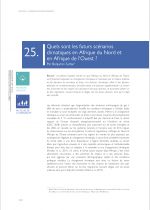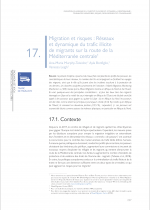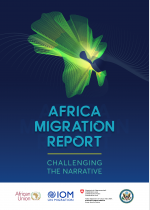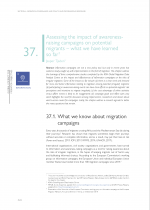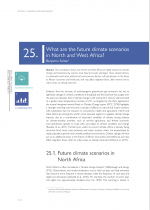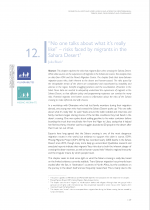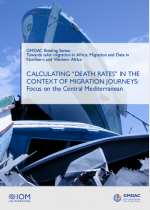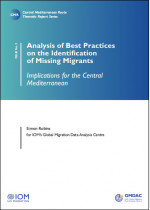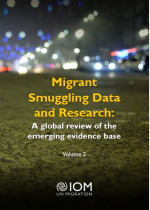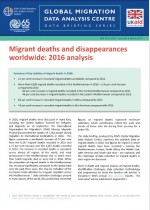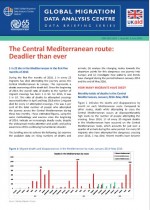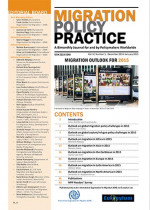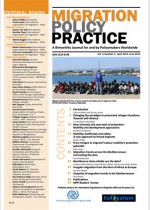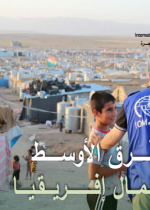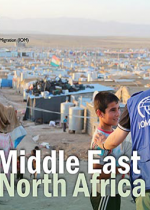Buscar libros
Displaying 1 - 29 of 29
Le présent chapitre expose les conclusions de trois études complètes menées par le Centre mondial d’analyse des données sur la migration de l’OIM sur les effets et l’efficacité des campagnes d’information sur les risques de la migration irrégulière.
Le présent chapitre montre en quoi l’Afrique du Nord et l’Afrique de l’Ouest sont fortement exposées au changement climatique et menacées par la chaleur extrême et des pénuries de nourriture et d’eau. Ces facteurs climatiques, alliés à des facteurs politiques et socioéconomiques, vont faire peser... Read More
le présent chapitre a pour but de mieux faire comprendre les profils des passeurs, les caractéristiques de leurs réseaux, la manière dont ils accompagnent ou facilitent les voyages des migrants, ainsi que le rôle qu’ils jouent dans les incidents touchant à la protection de ces derniers. Les données... Read More
Le présent chapitre traite des risques que courent les migrants lorsqu'ils traversent le Sahara. Alors que les sources de données sur les expériences vécues par les migrants dans le Sahara sont rares, cette analyse s'appuie sur des données provenant de l'OIM et du Mixed Migration Centre. Il ressort... Read More
Le présent chapitre étudie l’utilisation des mégadonnées pour évaluer les « facteurs de répulsion » mensuels des migrations liées à l’asile à l’échelle nationale. Il s’intéresse en outre à la question de savoir s’il existe une corrélation entre, d’une part, les estimations de ces facteurs dans les... Read More
The Africa Migration Report takes a distinctly regional approach to inform knowledge on migration in Africa. This first edition, titled Challenging the Narrative, aims to deconstruct negative perceptions of migration in Africa by addressing contextual realities and bringing to light practical... Read More
This chapter explores the use of big data to estimate monthly country-level “push factors” of asylum-related migration. It also looks at whether estimates of push factors in countries of origin correlate with traditional data on irregular migration on the CentralMediterranean Route and asylum... Read More
Information campaigns are not a new policy tool, but only in recent years has evidence slowly caught up with implementation in the field of migration. This chapter outlines the learnings of three comprehensive studies completed by the IOM Global Migration Data Analysis Centre on the impact and... Read More
This contribution shows how North and West Africa are highly exposed to climate change and threatened by extreme heat, food and water shortages. These climatic factors, in combination with other political and socioeconomic factors, will add pressure in the future to African economies and... Read More
This chapter seeks to provide a deeper understanding of the profiles and network characteristics of smugglers, how they support or facilitate people’s journeys, as well as the role they play in protection incidents experienced by people on the move. The data analysed originate from the Mixed... Read More
This chapter explores the risks that migrants face when crossing the Sahara Desert. While data sources on the experiences of migrants in the Sahara are scarce, this analysis relies on data from IOM and the Mixed Migration Centre. The chapter finds that trans-Saharan migration poses risks, both... Read More
This edited volume provides comprehensive evidence on migration from and within West and North Africa and across the Mediterranean.
It highlights migrants’ agency and contribution to transnational development, as well as the inequalities that shape migration and the risks that migrants are exposed... Read More
Since the beginning of 2014, IOM’s Missing Migrants Project has recorded the deaths of over 20,000 people in the Mediterranean Sea as they tried to make the dangerous migration journey to Europe. Yet beyond the total numbers of fatalities, other approaches are needed to understand this catastrophic... Read More
Over the last decade, crossing the Central Mediterranean has become one of the deadliest journeys in the world for migrants, with at least 15,000 migrants having died on this route since 2014. The vast majority of bodies found are not identified, with net identification rates of migrant bodies... Read More
Migrant Smuggling Data and Research: A global review of the emerging evidence base (Volume 2) presents a unique review of what is being collected and what can be done to further build the evidence base on migrant smuggling globally. The second volume on the topic, and building on the 2016 report,... Read More
Trafficking in human beings (THB) and smuggling of migrants (SoM), two distinct but often interrelated phenomena, occur on a global scale. Searching for a way out of economic inequalities, environmental crises, armed conflict, political instability and persecution, and in view of tightening border... Read More
Over the past years, public attention has gradually turned to the experiences of migrants along the precarious Mediterranean routes to Europe. A large number of migrants continue to risk their lives crossing the Mediterranean Sea on the way to Europe, often enduring long and perilous journeys. A... Read More
Young migrants and refugees set out to escape harm or secure better futures – and face staggering risks in the process. For children and youth on the move via the Mediterranean Sea routes to Europe, the journey is marked by high levels of abuse, trafficking and exploitation. Some are more... Read More
The International Organization for Migration’s (IOM) Missing Migrants Project has recorded more than 7,500 people who lost their lives or went missing in the course of migration in 2016, a 30-per cent increase over the number recorded in 2015. More than 5,000 migrant deaths and disappearances were... Read More
During the first five months of 2016, 1 in every 23 migrants has died attempting to journey across the Central Mediterranean to Europe. This represents a drastic worsening of an already high death toll. Since the beginning of 2014, the overall ratio of deaths to numbers of migrant crossings has... Read More
What will the key migration policy challenges be in various regions of the world in the course of 2015? Are the levels and structure of migration flows likely to evolve, for example in terms of types of migration, source countries, and number and profiles of migrants? And what will be the key... Read More
The new issue of Migration Policy Practice focuses on the migration challenges facing the countries of the Middle East and North Africa (MENA).
The first article in this issue, by Enas El Fergany from the League of Arab States (LAS), addresses the important topic of how to promote regional... Read More
Migration Policy Practice welcomes the opportunity to publish a selection of some of the most noteworthy papers discussed at the 13th plenary meeting of the Transatlantic Council on Migration. The meeting examined the realities of the current global protection system and set out to identify gaps... Read More
In 2013, migration in the Middle East and North Africa took place against the background of numerous acute and protracted crises, political transitions, demographic disparities, and uneven labour supply and demand. Migration flows in the region are complex in nature and often result in significant... Read More
On 3 and 4 October 2013 the UN General Assembly will hold the second High-Level Dialogue (HLD) on International Migration and Development. In view of such a momentous event, this new issue of MPP is privileged to be able to offer a lead article by Peter Sutherland, the Special Representative of the... Read More
In October 2013, over 400 people lost their lives in two shipwrecks close to the Italian island of Lampedusa. While these two events were highly publicized, sadly they are not isolated incidents; the International Organization for Migration (IOM) estimates that in 2013 and 2014 nearly 6,500... Read More
One year on from the Arab uprisings, the historic events of 2012 look no less extraordinary by comparison. New governments took office after landmark sets of elections in Egypt, Tunisia, and Libya but often struggled with the difficult political and economic challenges they faced whilst engaging... Read More
In 2013, migration in the Middle East and North Africa took place against the background of numerous acute and protracted crises, political transitions, demographic disparities, and uneven labour supply and demand. Migration flows in the region are complex in nature and often result in significant... Read More
This study, by Altai Consulting for IOM’s Regional Office for the Middle East and North Africa (MENA), creates a fresh and updated understanding of the dynamics of migration flows across the Mediterranean. Fieldwork was conducted between November 2014 and February 2015 across seven countries in the... Read More

